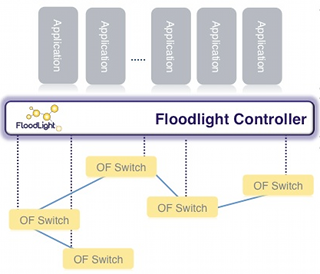Software Defined Networking and Cloud computing are two of the biggest trends in networking today. They are now both coming together in the Floodlight 0.85 release. Floodlight is an open source Software Defined Networking (SDN) controller, backed by networking startup Big Switch. The new 0.85 release will now integrate with the open source OpenStack cloud […]
Software Defined Networking and Cloud computing are two of the biggest trends in networking today. They are now both coming together in the Floodlight 0.85 release. Floodlight is an open source Software Defined Networking (SDN) controller, backed by networking startup Big Switch.
The new 0.85 release will now integrate with the open source OpenStack cloud platform enabling SDN control across a cloud environment.
platform enabling SDN control across a cloud environment.
“Floodlight offers a central management point for OpenFlow networks – it can manage devices like open vswitch transparently for OpenStack,” Mike Cohen, product manager at Big Switch, told InternetNews. “In fact, Floodlight also supports a broad range of physical OpenFlow switches on the market today as well so it greatly simplifies network management. ”
OpenFlow is the primary SDN protocol in use today to enable SDN. With SDN the control and data plane of a network is separated enabling broader network programability. OpenStack is an open source multi-stakeholder cloud project which has the support of IBM, HP, Dell, Cisco, AT&T, Red Hat, SUSE and Canonical among other big name IT vendors.
OpenStack has its own networking project called Quantum which enables some virtual networking capabilities by way of the vSwitch virtual switch. Going beyond what Quantum on its own provides, Cohen noted that having the Floodlight SDN controller will provide additional functionality. He explained that Floodlight will enable administrators to create isolated multi-tenant virtual networks using physical and hypervisor-based OpenFlow switches. Multiple vendors including HP, Juniper and Cisco have varying degrees of OpenFlow support available today on switching platforms.
With Floodlight, Cohen also commented that an administrator can have an enterprise class controller as the central point of management for all OpenFlow switches in an OpenStack deployment.
“This allows an admin to, among many things, easily audit and monitor network state,” Cohen said.
In addition to supporting OpenStack with the new Floodlight release, Cohen said that Big Switch plans to contribute its Floodlight plugin to the OpenStack community and already has developers active in the Quantum community. He added that as Big Switch grows as a company, the plan is to increase activity and code contributions.
“We see OpenStack as an ideal match for the Open Software Defined Networking Platform we are building,” Cohen said.
While OpenStack is the biggest change in the Floodlight 0.85 release it isn’t the only change. The release also marks the introduction of the first Floodlight user interface.
“This interface was contributed by developers at IBM,” Cohen said. “We have also been working closely with Canonical to package Floodlight for the Ubuntu platform.”
With the 0.85 release of Floodlight out the door, there is still much work to be done on the open source OpenFlow controller. Cohen said that Big Switch is now looking at adding persistent storage, multi-language support (ie. python, etc.), Flowvisor integration, and a number of other things as well.
While Floodlight remains a freely available open source project, the commercial version of Floodlight isn’t as easy available. The Big Switch commercial products are still in closed beta.
Big Switch co-founder Kyle Forster told InternetNews earlier this year that the commercial release would be likely available inside of this year.
Sean Michael Kerner is a senior editor at InternetNews.com, the news service of the IT Business Edge Network, the network for technology professionals Follow him on Twitter @TechJournalist.

Enterprise Networking Planet aims to educate and assist IT administrators in building strong network infrastructures for their enterprise companies. Enterprise Networking Planet contributors write about relevant and useful topics on the cutting edge of enterprise networking based on years of personal experience in the field.
Property of TechnologyAdvice. © 2025 TechnologyAdvice. All Rights Reserved
Advertiser Disclosure: Some of the products that appear on this site are from companies from which TechnologyAdvice receives compensation. This compensation may impact how and where products appear on this site including, for example, the order in which they appear. TechnologyAdvice does not include all companies or all types of products available in the marketplace.